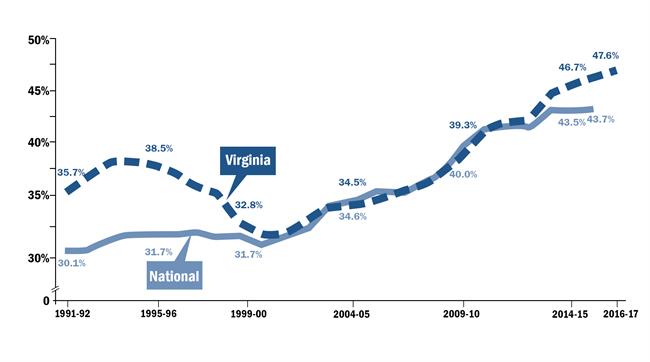by James A. Bacon
Against the backdrop of controversy over the University of Virginia’s $2.3 billion pot o’ money, the State Council on Higher Education in Virginia (SCHEV) has published its annual update on tuition & fee trends in Virginia public universities, reminding us that what’s happening at UVa is symptomatic of a larger trend: Tuition & fees are out of control at all four-year institutions.
Referring to the 2016-2017 academic year, here’s how the report leads off:
Most in-state undergraduates attending Virginia’s public colleges and universities will see their tuitions and mandatory fees increase this year an average of $369, or 3.6 percent, the lowest such rate in 15 years. Including only tuition and classroom-related fees, the average increase for those students came to 2.9 percent.
The state’s increase in funding for higher education made possible the lowest increases in 15 years for most students, Dan Hix, SCHEV’s finance policy director told the Richmond Times-Dispatch. “These things combined make it a very good time to be a student in the commonwealth.”
The latter statement is almost incomprehensible. From an affordability perspective, it is the worst time to be a student.
Average tuition increases may be the lowest in 15 years, but a 3.6% increase exceeds an inflation rate running about 1% by a wide margin. And, according to the data in the same SCHEV report (see chart above), total undergraduate charges as a percentage of per capita disposable income will increase by 0.9% points to 47.6% — a new high.
Incredibly, the Times-Dispatch treated the SCHEV report as a quasi-good news story. “Average tuition increases held in check,” read the headline. That echoed the body of the article, which noted that SCHEV found “only a moderate rise in college costs.”
The astonishing fact is that tuition increases continue to outpace incomes and inflation by a wide margin despite a significant increase in state aid to higher education.
What is going on? Why is the problem endemic? Lacking a profit motive, four-year colleges are prestige-maximizing institutions. Other than historically black universities, which are hanging on for dear life, every public four-year institution in Virginia strives to hire more renowned faculty, increase average student SAT scores, build more magnificent buildings, accumulate larger endowments. and (if they conduct research) to attract more R&D activity. UVa and William & Mary want to become public ivies. Virginia Tech aspires to be a Purdue or Michigan. Virginia Commonwealth University and George Mason University want to break into the ranks of nationally recognized institutions.
When no one is happy being who they are right now and everyone is seeking to rise in comparison to institutions driven by the same imperative, there is never enough money and there never will be. The system is broken. As long as colleges have a limitless appetite for money and the federal government provides a limitless supply of student loans, tuition & fees will continue to rise.



